Spotlight Story
Bag bans bring parks a holiday gift
April 24, 2014

Griffith Park Maintenance Supervisor Michael Watkins says the bag measures are "definitely working."
As the guy in charge of picking up Griffith Park’s litter, Michael Watkins usually dreads this week.
“Easter is our busiest day of the year, by far,” says the park maintenance supervisor. “We get about ten times the normal amount of garbage. Doing what I do on the week after Easter is like working at Macy’s on Black Friday or being a tax man on April 15.”
This year, however, the bunny left a pleasant surprise for Watkins: a notable reduction in one of his least favorite trash items—single-use plastic bags.
“That bag ban the city passed is definitely working,” he said. “Usually the wind blows them everywhere—up in the trees, along the fence line. This year, there weren’t as many. I can see a huge difference.”
In January, after years of analysis and discussion, the City of Los Angeles became the largest city in the nation to ban plastic bags. The ordinance made the city one of more than 100 California municipalities to outlaw the flimsy, disposable sacks, which can take centuries to decompose, but which are rarely recycled. Used and tossed by the millions, the bags typically end up in landfills after a single use, or blow out onto the streets, storm drains and beaches, where they endanger fish and wildlife.
At the time, opponents of the ban and representatives of the plastic bag industry argued that the bags’ environmental impacts were overblown. But as the area covered by bans has grown to encompass about a third of California’s population, those on the front lines say they’re beginning to see a difference.
A study done in the aftermath of San Jose’s comprehensive 2012 bag ban found that plastic bag litter had dropped by 89 percent in the storm drain system, 60 percent in creeks and rivers and 59 percent in streets and neighborhoods.
“We’ve been seeing a lot less of them, which is good because they’re a real eyesore,” says Shawn Wright, a maintenance worker at Whittier Narrows Recreation Area in unincorporated Los Angeles County, where a county ban on single use plastic bags has been in place since July 2011.
“Of course, there are still some around, blowing into the lakes and onto the fence line, and we still have all the other debris,” Wright said. As usual, he said, it was taking days to clean up the mess left by the tens of thousands of picnickers who had filled—and refilled—the 15-acre park’s trash bins on Sunday.
“The little plastic eggs, the candy wrappers, the confetti, the watermelon rinds, the mango peels, the aluminum foil from the barbeques, the charcoal bags . . . “
Maintenance workers noted one downside to the bag bans: Without plastic bags to fall back on, picnickers seemed to have fewer options to consolidate their trash.
“People would use them to carry, say, their hamburger buns into the park, and then put their empty Coke cans and napkins and whatever into them and toss them when they were finished,” says Rich Cambaliza, a manager for Rich Meier’s Landscaping in Lancaster, which helps maintain El Cariso Community Regional Park in Sylmar. “They were a pain in the butt, but people did have them when the trash cans overflowed.”
And the bag bans have forced picnickers to improvise with leftovers as well, says Steve Dennis, El Cariso’s landscape contract monitor.
“I’ve been seeing people using our Mutt Mitts—the bags we supply here at the park for dog waste—to take home their leftover barbeque or whatever,” says Dennis, laughing that the trick is giving new meaning to the phrase “doggie bag.”
“Hey, they’re clean and right from the manufacturer. I guess you just have to look past what they’re actually supposed to be used for,” he laughed.
At Griffith Park, Watkins says cleanup crews enlisted the public’s help on Sunday, handing out trash bags and asking them to pitch in. By Tuesday afternoon, he said, the cleanup was almost finished—and he had a new candidate for least-favorite garbage.
“If only we could get people to stop using that damned plastic Easter grass,” he said.
Posted 4/24/14
A new Dawn at the museum
April 16, 2014

After overseeing high-visibility projects all over the county, Dawn McDivitt is ready for a new challenge.
Want to explore the Dawn McDivitt map of Los Angeles?
Here’s an itinerary, just for starters:
A gleaming architectural gem (Disney Hall), an international symbol of great music (the Hollywood Bowl shell), a splashy Civic Center hot spot (Grand Park), a state-of-the-art medical facility (LAC+USC Medical Center), an imposing lockup on the outskirts of downtown (Twin Towers Jail), even a tarry pond right beside Wilshire Boulevard, complete with prehistoric mammoth figures (the La Brea Tar Pits lake bed.)
Over more than two decades, McDivitt has managed projects to build, rebuild or revamp all of those, along with numerous other L.A. County facilities ranging from fire stations to swimming pools. It’s an extensive body of work that has served untold tens of thousands of residents and visitors from every walk of life.
While her pivotal role in bringing all those projects to fruition may be little known to the general public, around the county Hall of Administration, McDivitt is something of a capital projects rock star, with her exuberant laugh, infectious enthusiasm (a favorite adjective: “fabulous!”) and widely-respected ability to get things done.
But, after helping guide the course of more than $2 billion in projects as a manager in the Chief Executive Office, the 56-year-old McDivitt is about to notch a new destination on her professional map: the county’s venerable Natural History Museum.
On May 1, she becomes the museum’s chief deputy director, serving as its No. 2 executive under president and director Jane Pisano.
“She has worked on so many major cultural projects in the county. She really understands and values public-private partnerships and getting things done,” Pisano said. “She is going to be such a great fit here.”
In addition to the main museum in Exposition Park, McDivitt in her new position also will oversee the Page Museum at the La Brea Tar Pits and the William S. Hart Ranch and Museum in Newhall.
“For me, it’s a time for something new, and moving outside of the comfort zone,” McDivitt said on a recent sunny afternoon as she left her 7th floor office to walk through one of her signature accomplishments, Grand Park. “Especially when you stop and realize you’ve been in a place for 20 years.”
The attraction—and the challenge—will be learning to lead a new team in a new environment with a lot of new responsibilities, from human resources to technology, along with more familiar duties like overseeing projects.
“I’m looking forward to learning…I always thrive on knowledge, anyway. I think if you continue to learn, you continue to expand as a person,” McDivitt said. Plus, she added: “I think it’s going to be a really cool environment to work down there because I absolutely love history.”
Like many Angelenos, McDivitt has early memories of going to the Natural History Museum and the Page as a child. And in her professional capacity, she got the chance to oversee a challenging project on the Page/Tar Pits grounds in 2011 when it turned out that the lake was seeping oil and gas into storm drains when it overflowed.
She supervised the CEO’s staff in managing the effort to install a new underground water purification system and connect the tar pits lake to the city sewers beneath Wilshire Boulevard.
Fix-it operations are nothing new to McDivitt.
“It’s kind of like that little Dutch boy with his fingers in the dike,” she joked. “There are times that I just want to pull my finger out and see what happens!”
She’s kept trouble at bay countless times, perhaps most prominently when glare from the new Disney Hall was found to be reflecting into nearby condominiums and onto the street. The solution: Workers with hand orbitals sanded down part of the surface.
Then there was the discovery of human remains during construction of LA Plaza de Cultura y Artes. After expert consultation, the bodies and artifacts were reburied in a special memorial garden at the site.
Even Grand Park needed some emergency trouble-shooting after its inaugural event—a big participatory dance-fest—reduced the Performance Lawn to a “mud pit.” (A new underground drainage system is now in place to prevent a repeat performance.)
McDivitt said she has learned how to listen first and let solutions emerge from dialogue.
“Staying calm is a really good challenge to me since I’m Irish,” she said. “So I tend to want to react and solve a problem right off the bat, and think of a solution before I actually listen to everything. My sisters tend to say to me, ‘OK, I’m calling to talk to you and I only want you to listen. Don’t solve the problem. I want you to listen.’ “
McDivitt said she is leaving behind a “great team” to carry on the capital project work, including upcoming phases of the Grand Avenue Project. (A Frank Gehry-designed development to be built across from his acclaimed Disney Hall is expected to come before the Board of Supervisors later this month, before McDivitt departs.)
But she’ll be taking with her something rare and precious: the opportunity to watch in delight as her work took on a life of its own.
“Look how much it’s being used,” she said as she strolled through Grand Park, children frolicking in the fountain and grownups lingering over lattes at café tables. “This is fabulous! That just feels so exhilarating—especially when you’re in the public sector.”
Posted 4/16/14
Spreading the CicLAvia spirit
April 3, 2014

Folks from New Brunswick, New Jersey, above, to Santa Cruz are catching CicLAvia fever. Photo/Frank Villafañe & Rose Rios
Everybody wants to play in the streets these days.
And CicLAvia, a stereotype-busting open streets free-for-all that became an overnight sensation when it rolled into Los Angeles four years ago, has grabbed the handlebars of what’s becoming a nationwide movement, from small towns to big cities.
As 2014’s first CicLAvia prepares to cruise down a car-free Wilshire Boulevard Sunday, L.A. is hosting the first-ever Open Streets National Summit, drawing activists from around the country who want to see how a metropolis allegedly addicted to automobiles is using CicLAvia to reinvent itself.
Summit organizer Michael Samuelson said L.A. was chosen precisely because of the success of CicLAvia, which regularly draws crowds in excess of 100,000.
“L.A.’s got a fantastic thing going,” said Samuelson. “It’s incredibly popular; the streets are packed with people biking and walking every time.”
The Open Streets Project is working in close collaboration with the CicLAvia organization, which will give summit attendees a behind-the-scenes look at one of the most successful open streets initiatives in the nation, said Aaron Paley, executive director and co-founder of CicLAvia. Paley said that the inherent challenges in shutting down major roads in a city like L.A. are a big part of the success story.
“We are the car capital,” Paley said. “There’s this idea that if you can do it in L.A., then the sky’s the limit.”
CicLAvia started in October, 2010, as a once-per-year event inspired by mid-1970s ciclovias in Bogotá, Colombia. (“Ciclovia” translates roughly to “cycleway.”) By 2013, CicLAvia had grown to three events a year. Paley said that he expects L.A. County to get even more open streets events like CicLAvia as funding grows. “There will probably be 10 or 12 events happening around the county each year,” he said.
As CicLAvia gears up to play an even bigger role in L.A., other communities across the country are hopping aboard. As recently as 2007, only eight or nine open streets events were being held across the country, according to Samuelson. Now, they’re taking place in more than 100 cities across North America.
Some of the initiatives, like Sunday Streets in San Francisco and Summer Streets in New York City, have been serving large, bike-savvy populations for years. But the movement is also gaining traction in cities like New Brunswick, New Jersey (pop. 56,000), which held its first ciclovia last October.
“People were asking ‘Why are we doing this?’ They focused on the negative,” said Jaymie Santiago, organizer of the event and director of program operations for New Brunswick Tomorrow. “It exceeded all our expectations. We expected 2,000 people and got 4,500.”
Building on those results, New Brunswick Mayor James Cahill doubled down, partnering with the organization to produce three more ciclovias this year, starting May 4. Santiago is attending this weekend’s summit so he can bring home valuable lessons and perspective.
“Because of the scale of Los Angeles, it sets an example for smaller cities,” Santiago said. “If L.A. can do it, then New Brunswick can do it.”
At the summit, Santiago plans to share some of the early success of his event, which he said is a useful tool in his organization’s fight against poverty in New Brunswick. “One of the symptoms of poverty is isolation,” he said. “By hosting an event like this and reclaiming the streets, it kind of breaks through that.”
Jenn Graham, an organizer for Atlanta Streets Alive in Georgia, hopes the summit will provide her with ideas on how to partner with her city better. “Our event sticks out like a sore thumb because it’s one of the few that’s not organized by the city or in partnership with a city,” she said. While Atlanta Streets Alive has been able to draw some funding from the city of Atlanta, it has relied primarily on cooperation with businesses and nonprofit organizations. Still, Atlanta Streets Alive has grown rapidly, from about 1,500 people in 2010 to 83,000 last October.
Closer to home, Saskia Lucas of Santa Cruz Open Streets said she is “totally excited” to get her first taste of what she called “the largest open streets event in the United States.”
“I’ve watched videos online and it is just so inspiring to see these thousands of Angelenos just taking over major Los Angeles streets with smiles plastered on their faces.”
More of those smiles may be on tap. Last summer, Metro’s Board of Directors invested $2 million in expanding open streets events to all parts of Los Angeles County. A few months later, the board approved a grant program for local groups seeking to produce events.
The Open Streets summit starts on Friday, April 4. About 75 organizers from across the country will gather at the Line Hotel in Koreatown to share ideas, stories and advice on everything from how to grow partnerships with cities to the technical aspects of producing a safe and successful event.
Things culminate with Sunday’s CicLAvia, which will run from downtown to LACMA, in the Miracle Mile district. Locals and visitors alike will be saying so long—for now—to the six-mile long “Iconic Wilshire Boulevard” route, which is going on hiatus as construction of the Purple Line Extension prepares to get underway.
But never fear: This is Los Angeles, where another CicLAvia always seems to be right around the corner. The next one is coming on October 5 in the “Heart of L.A.” Then, on December 7, the route will focus primarily on South L.A. for the first time ever.
Posted 4/3/4
A Cinderella moment
March 27, 2014
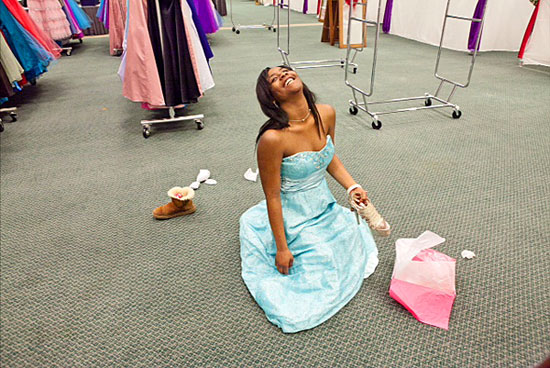
Foster teen Lisa Slayton gets a makeover at last year's Glamour Gown extravaganza. “It was like a blessing,” she says. “Fabulous.”
It was an invitation that another teenager might have taken for granted. Alexx Solyom had been asked to her first winter formal, a masquerade ball in January at Pasadena’s posh Brookside Country Club. It was her senior year. The entire Class of 2014 would be there.
“But I’d been in foster care for about two and a half years,” the 17-year-old said, “and I was living from foster placement to foster placement. I couldn’t afford a dress—I was in a group home and there weren’t enough funds.”
Enter Pam Bingham, the court-appointed special advocate for Alexx, who knew about a program just for girls in her situation. Within days, the teenager was heading home with a free, brand new, floor-length dress.
Their fairy godmother? Glamour Gowns, a collaboration between CASA of Los Angeles and hundreds of volunteers—many veterans of show business—who believe that girls in the foster care system should, like any girl, get to feel like Cinderella on prom night.
“It was a black and white dress, a long dress with crystals going around the front,” says Alexx, recalling how Bingham had kept it at her house in San Gabriel until the big night so it wouldn’t end up being damaged or vandalized in the group home.
“I felt like a princess.”
Now in its 13th year, Glamour Gowns is gearing up this week for its largest-ever Cinderella moment, an event that on Saturday will offer a free prom outfit and day of beauty to some 500 high school girls in foster care.
Initially launched by a handful of volunteers with a few dozen cast-off dresses, Glamour Gowns has since outfitted thousands of foster girls for proms, homecoming dances and winter formals. Its signature spring event, geared to prom season, has become such an annual extravaganza that the Los Angeles Convention Center now houses it.
Sponsors include: Chinese Laundry, which donates new shoes; Jenette Bras, which custom-fits each girl with appropriate foundation garments, and D.J. Bronson Inc., a Commerce-based apparel manufacturer that over the past five years has donated more than 5,000 new dresses—and, occasionally, tuxes—to grateful foster girls.
Meanwhile, members of I.A.T.S.E. Motion Picture Costumers Local 705, Costume Designers Guild Local 892 and Theatrical Wardrobe Union Local 768 donate their time, as do hair and makeup stylists.
“I know to some people it might sound frivolous, but it absolutely isn’t,” says Jennifer Parker-Stanton, a former costumer for film and TV who has been involved in nearly every Glamour Gowns event since its founding.
More than 28,000 children are under the jurisdiction of the dependency court in Los Angeles County and more than 17,000 live in foster care. Often, Parker-Stanton says, their caretakers can’t—or choose not to—afford “non-essential” yet emotionally important items like prom regalia. As a result, she says, girls in foster care often simply opt out of key adolescent milestones rather than risk more disappointment in a life that often is already painful.
“This is about self-esteem,” says Parker-Stanton, whose costuming work ranged from the TV series “Nash Bridges” to the Academy Award-winning “Million Dollar Baby”.
“The first time I did this, the girl I was working with looked in the mirror and said, ‘People say I’m pretty, but until now, I never thought so.’ And I thought, ‘All this time that I’ve spent running around, shopping for famous people, when you can change a life with just one dress.’”
“It’s a social experience that the girls never forget,” agrees Michael Williams, a veteran social worker with the Department of Children and Family Services who has seen at least five of his young clients transformed by the program. “Most of them have never gotten this kind of attention before. “
Anissa McNeil, a Glamour Gowns Committee member and CASA of Los Angeles board member, says the teenagers are often most surprised to see that the outfits are department store-quality merchandise, not hand-me-downs or seconds.
“They’re like, ‘You mean I get to keep this?’ And we say yes. ‘And it’s all new?’ Yes,” McNeil laughs. “One girl made me pinky promise one year that everything was free.”
McNeil says, the group makes sure no one leaves empty-handed.
“Last year, we had a plus-size young lady and she didn’t see any dresses she liked that were the right size, and you could just see her thinking, ‘Nothing ever works for me.’ She was saying, ‘Thanks for inviting me, I’ll just take a purse if that’s okay,’ when the seamstresses came in and…made a gown for her, right there on the spot. When she tried it on, and it fit like a glove, the look on her face—well, there wasn’t a dry eye in the house.”
McNeil says the event is particularly rewarding for her because she, too, spent time in foster care. “My mother had a nervous breakdown, and my brother and I became homeless when I was six,” she remembers. “Our grandmother raised us and became our legal guardian.”
Today, McNeil has a doctorate and a practice as an educational consultant, but remembers keenly the challenges that face foster children. She had to work two jobs in high school to pay for her prom dress, she says, and because she is over six feet tall, it had to be specially tailored. Then, on the big night, her date failed to show up.
“Hey, that’s what happens when you go for a playboy,” she recalls laughing. “But as my brother and I tell people, if you can overcome being homeless, you can overcome anything. I was determined to go, and I went by myself—in a gown that was long and blue and elegant.”
Posted 3/27/14
Charting a sea change
March 20, 2014
Hotter heat waves in the Valley. Smaller snowcaps in the mountains. Worse flooding during storms on Pacific Coast Highway. Study by study, local scientists are gradually pinpointing the ways in which climate change could impact Southern California. The news has been sobering.
Now, the county is preparing to zoom in on another piece of the picture, with a look at rising sea levels at the 21 beaches it operates and maintains. Approved this week by the Board of Supervisors and funded in large part by a grant from the California Coastal Conservancy to the county Department of Beaches and Harbors, the $86,815 study will run from April to October, and add to a growing body of work on the local impact of climate change.
“There have been broad projections about what sea level rise might look like, but that picture isn’t specific enough for what planners and policy makers need,” says Megan Herzog, a fellow at the UCLA law school’s Emmett Center on Climate Change and the Environment.
Although the City of Los Angeles has made some headway, most notably with a recent study on the potential impact of sea-level changes along the city’s coastline, “most local governments are just at the data gathering stages,” says Herzog. “So we’re really just at the beginning of thinking about impacts and making plans.”
With more than 52 million visitors a year just at the beaches that are county-owned or -managed, a full assessment of the coastline’s vulnerability is critical both to the environment and to the economy, says Kerry Silverstrom, chief deputy director at Beaches and Harbors.
“One study found that sea levels on the West Coast have risen twice as fast over the last five years as they did over the last twenty,” says Silverstrom, noting that the sea level is projected to rise by up to two feet by 2050. “So we need to look at what are we going to do as operators of the beaches to protect them?” she says.
Higher tides not only can flood low-lying buildings and roads, but can also exacerbate storm damage by undermining parking lots and damaging coastal sewer lines. These issues are of particular importance on the county-maintained and operated beaches, which range from Royal Palms in the South Bay to Malibu’s Nicholas Canyon, and include such landmarks as Marina Del Rey, Point Dume and Venice Beach.
The city’s January sea level study, done in cooperation with USC, found that the Port of L.A. and energy facilities along the coast were in good shape to withstand the impact of rising sea levels. However, low-lying communities such as Wilmington, San Pedro and Venice are especially vulnerable, as is Pacific Coast Highway, which already floods regularly in some places when winter storms hit.
The study found that even a moderate storm could do more than $400 million in damage on the city’s share of the beaches if the sea level were to rise here by just 18 inches or so, a mark that easily could be reached by 2050. Also at risk are wastewater and drinking water systems near the high tide line.
Charlotte Miyamoto, head of the planning division at Beaches and Harbors, says the county’s research will have big implications for county public works projects such as sea walls and sand berms—protective structures that the county uses to prevent crashing waves from scouring beaches, undermining parking lots and flooding Pacific Coast Highway.
Although critical in mitigating the ocean’s impact on infrastructure on which the public relies, residents in Venice and Marina Del Rey have complained that the temporary berms, in particular, block their view of the ocean—a complaint that seems likely to be amplified as rising sea levels raise the risk of damage from storm surges.
“How big and wide will we need to make those berms?” says Miyamoto. “Will we want to build structures in the water to deal with erosion? The beaches are our first line of defense as the sea level rises,” says Miyamoto, “and so we want to make sure they’re preserved.”
More broadly, the county study also will help focus policy choices, says Herzog. Already, she noted, coastal cities elsewhere in California are moving bike paths and other amenities away from narrowing beaches and rising tides.
“This region is really densely developed along the coast,” she says. “In some cases, we have development right up along the backs of beaches, and that’s going to mean we have to think about priorities. We have to decide if it’s important to preserve beaches and wetlands and ecosystems, for instance. And if it is, then it’s going to mean tough decisions about development up and down the coast, and it could mean major changes in land policy over the long term. Because something has to move.”
Silverstrom noted that the Beaches and Harbors study, while narrow, is just one part of a broad effort the county has been undertaking for the past two years to prepare for climate change. A series of climate change studies led by the UCLA Institute of the Environment and Sustainability has projected, among other things, that average annual temperatures in Greater L.A. will rise by an average of 4 or 5 degrees by 2050, that days of extreme heat will quintuple in inland areas and the valley and that the area’s mountains will get about a third less snowfall.
So, acting on a 2012 motion by Supervisors Zev Yaroslavsky and Michael Antonovich, county departments across the board have been assessing the potential impact of climate change and trying to mitigate its potential costs.
The county Fire Department, for instance, has revised training protocols to account for the warming climate. The Internal Services Department has been working to reduce the carbon footprint at county buildings and to improve energy efficiency. The Department of Public Works, meanwhile, has been trying to capture more storm water, and to replace gas-fueled trucks with more eco-friendly vehicles.
Silverstrom of Beaches and Harbors says the latest study will help pave the way for short, medium, and long-term solutions to rising sea levels, coastal erosion and more powerful storms in the future.
“This is about resilience,” she says, “about how we can sustain our beaches for the public while recognizing what’s happening in the environment.”
A Strad-studded event
March 13, 2014

Elizabeth Pitcairn's Red Mendelssohn will be among eight Stradivari violins at the L.A.Chamber Orchestra's upcoming "Strad Fest" event. Photo/Joy Strotz
Jerry Kohl and his wife Terri are philanthropists from Pasadena and founders of the Brighton’s accessories chain. In their spare time, though, the Kohls are music lovers, and in 2006, they decided to buy one of the rarest and most coveted violins on the planet and make it available to musicians in Los Angeles.
“Stradivarius violins are like wines,” Kohl says. “There are good ones and then there are great ones, and all the great ones were being bought up by countries and museums, so it wasn’t going to be long before they were all gone. I wanted to see a great one here in L.A., and that’s how it started.”
Kohl called the curator of musical instruments at the Smithsonian for advice. He tapped Martin Chalifour, concertmaster at the L.A. Philharmonic. He called Margaret Batjer, the Los Angeles Chamber Orchestra’s concertmaster. He found dealers in London, Chicago and Vienna.
Finally, he narrowed his list to a handful of rare instruments, made during the brief “Golden Period” in which the legendary Italian luthier Antonio Stradivari was said to have done the work of a lifetime. Excitedly, he summoned all the dealers to Disney Hall for a play-off.
And when Batjer began to weep as she played the violin he eventually picked—a 1716 Stradivarius that had belonged to the virtuoso Nathan Milstein—Kohl says he realized he had witnessed “something magic”.
“It was as if she was playing a part of history,” he says.
Eight years later, Kohl and his violin are setting the stage for another magical and historical moment—one that, this time, will be open to all of L.A. From March 26-29, eight Stradivarii from the Golden Period will converge for an unprecedented series of concerts, inspired in part by the private “Strad fest” Kohl got to witness.
“Strad Fest L.A.” will feature some of the most storied instruments on the planet, played by some of the world’s finest musicians. Starting with a private March 26 reception for scholars at the Huntington Library, and encompassing public concerts in Downtown L.A. and Santa Monica before culminating at a Saturday night gala fundraiser, the series will feature not only Kohl’s violin but three other locally-owned Strads. Two will come to town with the violinists who’ll play them, while two more will be brought in from London by the son of Kohl’s dealer.
All told, the event will showcase many millions of dollars worth of 300-year-old masterpieces, a rare gathering, given that fewer than 650 of the 1,000 or so instruments made by Stradivari and his sons are still in existence, and only about 60 or 70 of them hail from the Golden Period, which—depending on collectors’ various definitions—ranges from about 1700 to the late teens or early 1720s.
And if some of the concerts have a “battle of the Strads” feel, it may be because Kohl—a major chamber orchestra supporter who made the largest monetary gift in the orchestra’s history last year—suggested the concept during a brainstorming conversation last year for the annual gala.
“I said, ‘For 300 years, scientists, musicians, violin makers, people of all sorts have tried to figure out why the Stradivarius is so magical’,” Kohl remembers. “’So why don’t you honor the violin?’”
The suggestion became “an inspiration,” the L.A. Chamber Orchestra’s executive director, Rachel Fine, says. “We realized there were actually quite a few Stradivari violins right here in town.”
Last season, for instance, Dr. William Sloan, a urologist and amateur violinist from Los Feliz, and his law professor wife, Judy, had loaned their 1714 “Leonora Jackson” Stradivarius to the orchestra’s assistant concertmaster for a world premiere. Violinists at the L.A. Philharmonic had access to several in the Phil’s collection, including the 1711 Stradivarius formerly owned by the great composer Fritz Kreisler.
The 1720 “Red Mendelssohn” Stradivarius that inspired the Academy Award-winning film, “The Red Violin” has been owned for years by violinist Elizabeth Pitcairn, who teaches at the Colburn School downtown.
Then there were all the friends of musicians at the chamber orchestra who had Stradivarius connections. Cho-Liang Lin, the music director of La Jolla Music Society’s SummerFest, owns the 1715 “Titian” Stradivarius, which is revered for its orange-red color and unusual power. Philippe Quint plays the 1708 “Ruby” Stradivarius, thanks to the Stradivari Society, which loans it to him.
“We started adding more and more Strads and more and more players who could play them,” says the chamber orchestra’s general manager, Andrea Laguni. “And then we decided that it seemed unfair to share this only with the few people who could attend the gala.”
So, Laguni says, they added the Huntington event “to share with another cultural institution and their base of donors,” and then inserted a cameo Strad appearance into an already-planned Thursday night Baroque Conversation. By that time, he says, it seemed only fitting to throw in the Friday night “FiddleFest” at Santa Monica’s Broad Stage, at which the violinists will attempt to outplay each other in a program of solos, duos, trios and quartets. Tickets for that event start at $45; the gala is $750 a head.
The planning took the better part of a year, Laguni says, although it was simplified by the fact that half of the violins—and half of the violinists—are from Greater L.A.
The musicians will range from world-renowned players like Chalifour to newcomers like Ray Ushikobo, a 12-year-old Riverside prodigy. And most will bring violins that they own or that are regularly on loan to them. The exceptions will be Ushikobo and Xiang Yu, another prizewinning young violinist; their violins—the 1666 “Serdet” and the 1720 “Beechback”—will be brought in for the occasion by the son of London violin dealer and expert Charles Beare.
Physician Sloan, who plays his Strad in a string quartet when he’s not loaning it out to professional musicians, says he plans to attend all but one of the StradFest concerts.
“Hardly anybody has ever heard eight Strads together—people buy them and hoard them,” he says. “Years ago, soloists had them, but now they’re so expensive that when the soloist dies and the family sells them, they go through banks or Fortune 500 collectors, like they’re boats or artworks or commodities.”
Periodically, a Stradivarius is stolen, although Laguni says their fame makes them almost impossible to resell. More typically, unscrupulous dealers try to fob off fakes and copies onto unsuspecting collectors, or super-rich investors buy them and take them out of commission. Many of the Stradivari violins in existence have ended up in museums, their famous, rich timbre forever silenced in the name of preservation.
“Every time a government or museum buys one, it’s off the market forever,” says Kohl, who keeps his “Milstein” in a downtown vault when it’s not being borrowed by musicians like Batjer or Chalifour or John William, who recently used it for a performance of the theme from “Schindler’s List” in Orange County.
So has he ever tried to play his?
“Oh, no, no, never, never, never, no,” the music lover says, laughing. “I’m not that brave.”
His preference, he says, is to sit in the audience, to listen and appreciate.
“You can sit in the last seat in the house and hear it,” Kohl says. “It just has this sound that just carries, that you can’t turn away from. It’s like Frank Sinatra walking into a restaurant—you notice. It’s magic. It’s going to be great.”

Los Angeles Philharmonic Concertmaster Martin Chalifour will be bringing one of the orchestra's Strads to the party. Photo/Eric Chalifour
Posted 3/13/14
A long-running debate
March 6, 2014
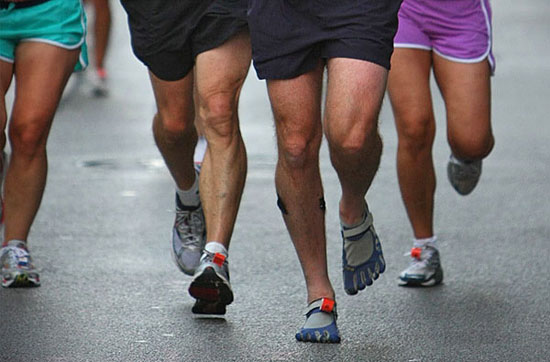
A revolution in distance running led some die-hard striders to wear practically nothing on their feet.
Visit the L.A. Marathon’s Facebook page and you’ll find yourself in a world of hurt.
“I start to lose feeling/circulation from my forearms up to my fingers,” one dispirited runner posted last week during a live chat with Dr. Seth Gamradt, director of Orthopedic Athletic Medicine at the Keck Medical Center of USC.
“I have pain when I bend my knee,” reported another would-be marathoner.
“My legs tend to [go] numb after 5 miles,” said yet another, followed by still others who complained of everything from shin splints to sprained ankles to stress fractures.
But ailing bodies weren’t the only concern as the 29th L.A. Marathon approached. One young woman weighed in with a question that has been the great obsession of the running community for the past several years, one that you might say has led to profound sole searching.
The young woman told Dr. Gamradt that she was worried about having “incorrect running form” and wondered whether she should change her style to land first on her forefoot, rather than on her heel. No way, he told her, it would take months for her body to become accustomed to a new foot strike.
“To dramatically change your stride for no reason is asking for trouble,” Gamradt, a triathlete, said the other day as he recalled the woman’s question. “Some people are developing stress fractures and injuries trying to convert to that style… My whole thing is that if you’ve been running well with your traditional foot-strike pattern, then what’s the reason to change?”
You might think that, of all sports, none could be simpler than one in which you simply put one foot in front of the other, even if it is for 26.2 grueling miles. But during the past few years, a revolution has occurred on the streets and in academia that has called into question the very notion of how we should run and what we should put on our feet, if anything.
In other words, there’s a lot more than meets the eye to those wildly-colored kicks you’ll see pounding the pavement during Sunday’s sold-out L.A. Marathon.
None of this is about getting to the finish line faster, the experts say. It’s about trying to sidestep injuries—a never-ending obsession for most runners, especially those who push their bodies to the brink and beyond.
For decades, running shoe companies have tailored their products to this injury-prone crowd, offering pricey shoes that claim to provide extra stability or cushioning, depending on a runner’s foot and gait. But in 2009, Christopher McDougall’s best-selling book, Born to Run, upended the industry’s conventional thinking and marketing machine.
In his book, McDougall chronicled the seemingly superhuman feats of the Tarahumara Indians of Mexico, who can run 100 miles a day across rugged canyons while wearing flimsy sandals assembled from strips of leather and old tire tread. McDougall argued that clunky, heavily-padded modern running shoes encourage people to unnaturally hit the ground first on their heels, sending excessive impact force through their feet and legs, increasing the risk of injuries. McDougall said his study of the Tarahumara Indians showed that, instead, runners should land gently on their forefoot, wearing as little shoe as possible or none at all.
The next year, a widely-publicized Harvard study seemed to back him up, suggesting that forefoot striking strengthens feet, reduces impact and helps runners avoid or mitigate such repetitive stress injuries as plantar fasciitis and “runner’s knee.”
Almost overnight, the era of barefoot running and “minimalist” shoes was born. Shelves in both specialty running stores and mass-market retailers were soon lined with light, flexible shoes that included a lower heel to help facilitate an easier forefoot strike.
Runner’s World writer Scott Douglas says that in 2012, “when minimalism was in its zealot phase,” he began work on a book about the phenomenon. But by the time “The Runner’s World Guide to Minimalism and Barefoot Running” was published last year, Douglas says, “the pendulum had begun to swing back.”
“I wrote it at exactly the wrong time,” says Douglas, a runner of 35 years. He says there’s now actually “a backlash against minimalism” as runners have come to realize that good, injury-free running involves more than shoes. In fact, a study published in January in the British Journal of Sports Medicine found that runners who switched to minimalist shoes, without slowly adapting to them, had two to three times as many injuries.
“It’s simplistic to think that by putting on new shoes, it’ll fix everything,” Douglas says. “Shoe selection is a part of that but certainly not all of it. The winner of the L.A. Marathon would still look amazing in old-style running shoes.”
Amby Burfoot has the long view of all this, having watched fads come and go in the running community for decades. In 1968, he won the Boston Marathon and has returned every five years since to run the world’s most famous race. A light heel-striker himself, he says that the single most important advice he can give runners is to not take overly long strides, which lead to an excessively hard heel strike.
“Most of the shoe cultist people, especially the ‘barefoot people,’ are now changing their tune. It’s not your shoe but your running form and foot strike that makes the difference,” says Burfoot. “The shoe companies, with their hordes of lawyers, are now being very careful about what they say about injuries and performance. They’re appealing to the soul of the runner, the persona of the runner. No one dares say their shoes will prevent running injuries.”
As for that pendulum, Burfoot agrees that it’s now swinging in a new direction. As proof, he says he need look no further than his own brother, who’s had great success lately with a new wave of shoes with “super thick soles.”
Their nickname: “maximalist.”
For Dr. Seth Gamradt’s tips on how to avoid injuries and stay strong for the marathon, click here.
Posted 3/6/14
Always a holiday for pet adoption
February 13, 2014
Some people just have a knack for matchmaking. Elaine Seamans, for instance, has arranged hundreds of long-term relationships.
Last Halloween, she helped kindle more than 80 love affairs in a day at the county’s Baldwin Park animal shelter. Dozens more found the mate of their dreams at her Fourth of July and St. Patrick’s Day pet-to-person meetups.
And this week, the county Department of Animal Care and Control will be expanding the shelter volunteer’s signature love fest—a hearts-and-flowers pet adoption extravaganza that has found homes for nearly 100 stray and abandoned animals during the last three years.
“The idea was just to use the holidays to celebrate adoptions,” says Seamans, a 58-year-old Valley Village designer who has been organizing “My Furry Valentine” at the Baldwin Park shelter since early 2011. “But this has just gotten bigger and bigger every year.”
Colorful and festive, the event turns the shelter into a giant Valentine for one day, welcoming prospective pet owners with chocolate, gift bags, music and doggie kisses. This year, each of the county’s six shelters will hold a more or less elaborate version of the Baldwin Park celebration through the Valentine weekend, with the usual $50 adoption fee discounted to a heartfelt $14.
Holiday-themed adoption events have been a growing trend for some time at rescue nonprofits—the Found Animals Foundation has long held an annual “Happy Pawlidays” campaign in December, for instance, and the Best Friends Animal Society holds an “aCATemy Awards” tied to Oscar season. But until recently, it was unusual for a county shelter to initiate this kind of promotion, according to animal control officials.
The reluctance stemmed partly from an ambivalence about holiday adoptions. People are tempted to give pets as gifts, “and having a pet isn’t like getting a sweater that you can return—it’s a lifetime commitment,” says county Animal Care and Control Director Marcia Mayeda.
But, she added, county shelters were also slow to get on the holiday bandwagon because the shelter staff is consumed with day-to-day animal care duties. Only in the past decade, she says, has the county shelter system developed a volunteer program with the base and coordination to do fundraising and event planning, and “a lot of this is dependent on volunteers.”
Seamans, who has been volunteering with Best Friends and other rescue nonprofits since the 1998 death of her dachshund Quackers, had been donating her time for about a year at the Baldwin Park shelter when she suggested to shelter manager Lance Hunter that more could be done to find homes for the bereft dogs and cats in the shelter kennels. That, she says, is when she pitched the Valentine idea.
“It started out as just this little grassroots thing with just a couple of volunteers and some decorations,” says Hunter. But when their usual rate of eight or ten adoptions per day nearly tripled, he says, he took Seamans up on her offer to do more holiday events.
Since then, he says, other county shelters have begun hosting their own festive campaigns, and no holiday has been left behind when it comes to rustling up homes for pets at the Baldwin Park shelter. Last year, Seamans and her fellow volunteers organized events at Christmas, Valentine’s Day, the Fourth of July and Halloween, which Hunter said “topped the charts” at the shelter for holidays.
Among the attractions at the Halloween event were a fog machine and buckets where humans could bob for apples and dogs could bob for cocktail wieners, says Seamans. But “My Furry Valentine” is still the most elaborate promotion.
“Last year Elaine put frames and flowers around the outside of the kennels, and hung signs all over that said things like, ‘Your Best Friend Awaits’ and ‘Your Heart Is Missing Something’,” laughs Hunter. “We even had face painting and a ‘kissing booth’ built with some of the donations. And she got a young actor she knew to dress up as Cupid.”
“This year we’re getting a harpist,” adds Seamans. “This woman is donating her time in honor of her retriever, who passed away in January. Can you imagine? A harp player in the kennel! I’m dying to see how the dogs react to that.”
Mayeda says holiday events not only save pets’ lives, but also generate donations to the county’s Animal Care Foundation and improve morale among the county’s now-thriving ranks of volunteers.
They also put a friendlier face on the county system, says Seamans.
“A lot of people think shelters are scary,” she says. “They think they’re death camps, or where the ‘problem dogs’ go.”
But when people actually meet the pets, she says, they’re less concerned about their surroundings. All three of the dachshunds she has now—Quizzie, Fred and Doodles—were strays or abandoned. And after the 2011 event at which her teenaged actor friend Lou Wegner played Cupid, he returned to shoot a music video at the Baldwin Park shelter to benefit pet rescues.
In any case, she says, few things are more heartwarming than matching the perfect pet with the perfect family. Take, for instance, the note she got from a young mother who adopted a little dog for her 6-year-old son on a therapist’s recommendation last Valentine’s Day.
“Ohhhh, she is soooo good. Her name is Sassy,” the mother emailed. “Since the day we brought her, she let us know when to take her outside . . . She does love the bed, so we suckered her into sleeping with us or the kids. She is perfect for us—thank you.”
And that, she says, is just the product of one love story among hundreds.
“I tell people that the shelter is where your best friend is waiting,” says Seamans. “These animals are out there just waiting to show you how great you are.”
For more on “My Furry Valentine”, click here. And for more on the county’s other pet adoption programs, click here.
Posted 2/13/14
We loved them yeah yeah yeah
February 6, 2014
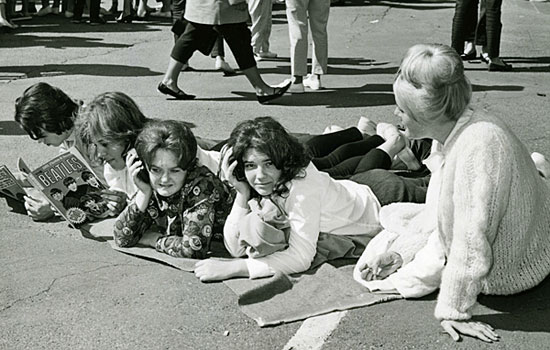
Fans mobbed the Hollywood Bowl for tickets to the Beatles' 1964 Los Angeles debut concert. Photo courtesy of The Music Center Archives/ Otto Rothschild Collection
It was 50 years ago this summer that four lads from Liverpool took the stage of the Hollywood Bowl, ushering in Beatlemania, Los Angeles-style.
Before the end of their 30-minute set on August 23, 1964, this much was certain:
A long-running love affair between the Beatles and Los Angeles was underway. Initially it involved mass hysteria, stealthy getaways, partying with local swells and celebrity hobnobbing on the Sunset Strip. Eventually it blossomed into “Breakfast with the Beatles,” a record label romance, a song, an uncomfortable meeting with Elvis in Bel-Air, even a Tower Records commercial.
At the same time, the Bowl itself was experiencing an electrifying new chapter in its fabled history, as a generation of screaming teenagers converged on the place where their parents had thrilled to popular stars like Frank Sinatra and classical music greats like Jascha Heifetz and Vladimir Horowitz.
Suddenly, it was a whole new ballgame.
“I think that night in 1964, that’s the most famous concert in American history, not counting Woodstock,” said Bob Eubanks, then a 26-year-old Los Angeles deejay and owner of two “Cinnamon Cinder” nightclubs, who produced the Beatles show by mortgaging his house for $25,000. “The boys at the Hollywood Bowl told us we couldn’t sell this thing out in one day, that it was physically impossible. Well, we sold it out in 3½ hours—without computers, by the way—and away we went.”

Paul McCartney backstage at the Bowl in '64. Photo courtesy of The Music Center Archives/ Otto Rothschild Collection
Along with thousands of smitten schoolgirls, stars like Lauren Bacall, Debbie Reynolds and Michael Landon turned out for the performance. Gossip queen Louella Parsons had to be relegated to the back benches—“she let us know about that for a long time,” recalled Eubanks, who went on to national fame as host of “The Newlywed Game.”
Ticket prices ranged from $3 to $7. Fans who couldn’t get in climbed trees around the amphitheater as “Twist and Shout,” “Can’t Buy Me Love” and “I Want to Hold Your Hand” rocked the Cahuenga Pass. After the final number, a cover of the Little Richard hit “Long Tall Sally,” the band was whisked away in a tiny compact car and was getting off the 101 Freeway at Sunset Boulevard before the audience knew what hit them. “The kids still thought they were there and they ruined two limos out back,” Eubanks said.
From his vantage point as a deejay at KRLA, the city’s top rock ‘n’ roll radio station at the time, Eubanks had known for months that something big was on its way.
“Suddenly, there were these four guys from England who just changed the world musically,” he said. “Our phones just started to ring off the hook…It started the night they did the Ed Sullivan show, quite frankly. When we heard they were coming to America, the country started to really buzz.”
This year, the buzz is back. With the 50th anniversary of the group’s first appearance on the Sullivan show taking place this Sunday, February 9, there’s no shortage of magazine covers and think pieces analyzing the British Invasion. And the Hollywood Bowl, where L.A.’s adventures in Beatlemania began, this week announced that it is marking the occasion with three “The Beatles’ 50th at the Bowl” concerts in August. (Those aren’t the only ‘60s flashbacks in store at the Bowl, by the way; the summer schedule also includes performances of the musical “Hair”—complete with “simulated drug use” and “brief nudity.” Check out the complete Bowl schedule here.)

Fainting girls went with the territory. Photo courtesy of The Music Center Archives/ Otto Rothschild Collection
Dave Stewart (of Eurythmics fame) will be “ringmaster and musical director” for the August 22, 23 and 24 Beatles shows at the Bowl, which will include yet-to-be-announced special guests and a re-creation of their original musical set from 1964.
Eubanks said he’d like to take part in the shows if possible. As the 50th anniversary approaches, he has also reached out to Paul McCartney. In an email reply, read by Eubanks in a telephone interview this week, the former Beatle demurred about his availability on the anniversary date but sent along reminiscences of the “heady days of our early trips to L.A.” and this message to fans:
“It was a fantastic time for us and I still have many memories of the things that we got up to. It was great to play the Hollywood Bowl even though our music was completely drowned out by the screams of our lovely fans.”
The Hollywood Bowl Museum is gearing up for the occasion as well. Carol Merrill-Mirsky, museum and archives director for the museum and the Los Angeles Philharmonic, which operates the county-owned Bowl, has commissioned a 3-D model of the Beatles in concert. It will be showcased this summer along with the small cache of Beatles memorabilia—including a copy of Eubanks’ contract for the 1964 concert—that’s on regular display.

Tickets for the 1964 show sold out in 3½ hours. Photo courtesy of The Music Center Archives/ Otto Rothschild Collection
She also has been combing through old pictures from the Music Center archives to put on display—although there are not a lot of images in the collection from that initial concert. She thinks that’s because, aside from Eubanks, few saw the magnitude of what was about to unfold that night.
“He had an instinct that it was going to be huge but nobody else did. Nobody. Certainly the Bowl didn’t, and the fact that we have so few photographs is proof that it was not a big deal. But it was a big deal to the fans—to those teen fans.”
Despite the frenzy among local teens, not everyone was thrilled to see the Fab Four arrive in Los Angeles in 1964. “They wanted to stay at the Ambassador, but the Ambassador didn’t want ‘em,” Eubanks remembered. A house in Bel-Air, complete with “a pool and the whole nine yards,” was lined up instead.
On the night of the concert, a busload of marshals showed up at the Bowl, ready for deployment to “protect the neighbors up in the hills.” Eubanks thought it was a great idea until he realized he was going to be footing the bill.
As a result, he said, he ended up making only about $4,000 on the 1964 concert. But Eubanks, who went on to produce all of the Beatles’ L.A. concerts—two performances at the Hollywood Bowl in 1965 and a 1966 show at Dodger stadium—did “quite well, thank you” on the later gigs.
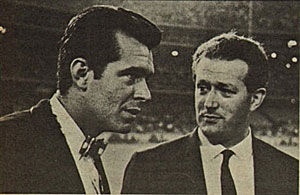
Eubanks, with Beatles publicist Tony Barrow at Dodger Stadium in 1966, witnessed the band's evolution.
He also had the priceless experience of seeing the band’s three-year evolution—from “wide-eyed and curious” in 1964 to seasoned “road warriors” in 1965 to “very difficult” in 1966.
After the last-ever Los Angeles show in 1966, he remembers arguing with John Lennon in the Dodgers’ dugout after the original getaway car failed to make it out of the stadium.
“We got into it pretty good with John down there because he wanted to get to a party. ‘You’ve gotta get us out of here.’ We went nose to nose. And finally I said, ‘I’ll get you out of here.’ We went upstairs and put them in the back of an ambulance.”
The driver “was nervous as heck. He drove right down through 40,000 people…he hit a speed bump and the radiator fell out of the ambulance.”
Finally, they reached a rendezvous point with an armored car that was intended to complete the trip away from the stadium. But it was mobbed with teenage girls and the Beatles’ escape seemed to be foiled again.
“And all of a sudden, I have no idea where they came from, the Hells Angels showed up,” Eubanks said. “They circled the armored car, the kids backed off, and the Hells Angels led the Beatles from Dodgers Stadium. And that was the last time I saw the Hells Angels or the Beatles.”
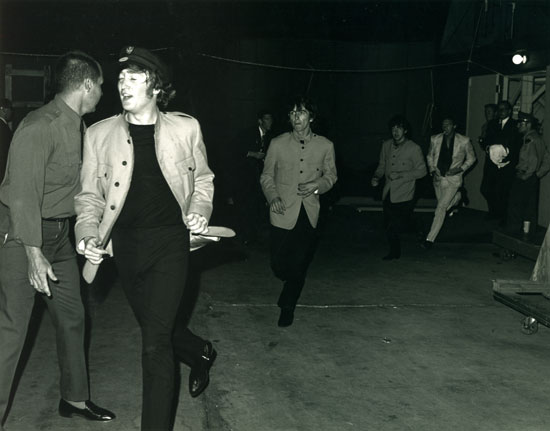
Running into the Bowl in 1965. Photo courtesy of The Music Center Archives/ Otto Rothschild Collection
Posted 2/6/14




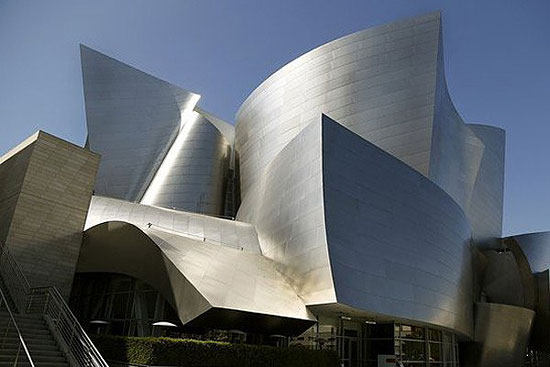
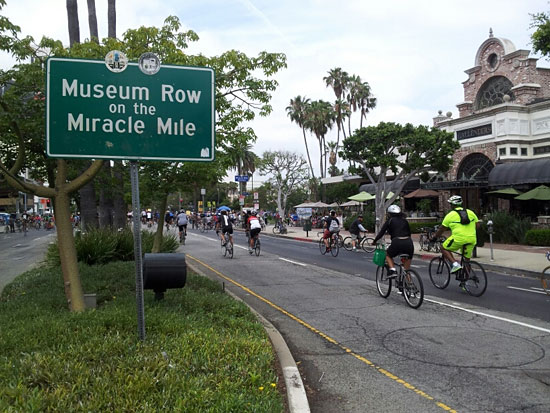

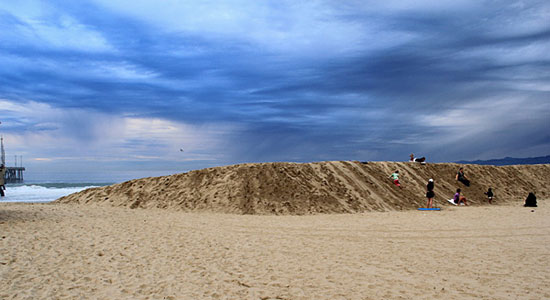
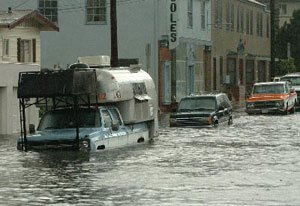

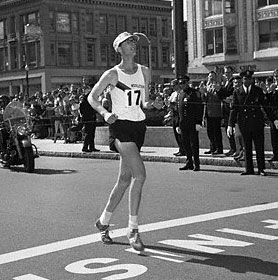
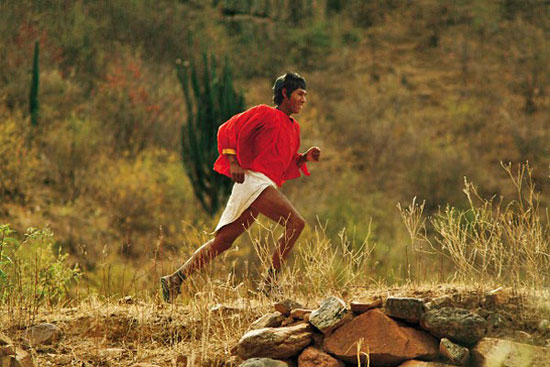
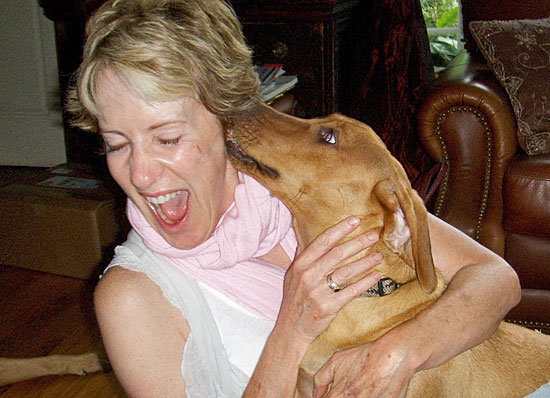
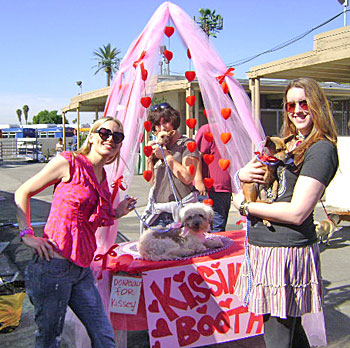
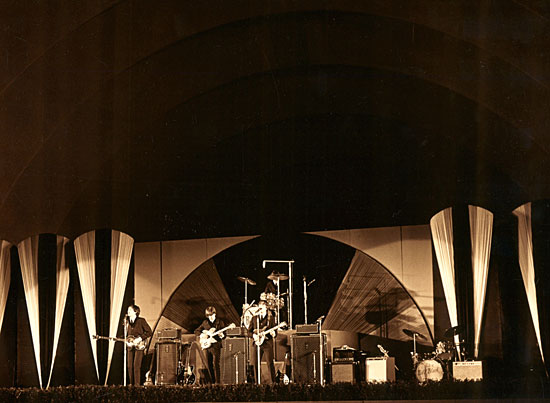
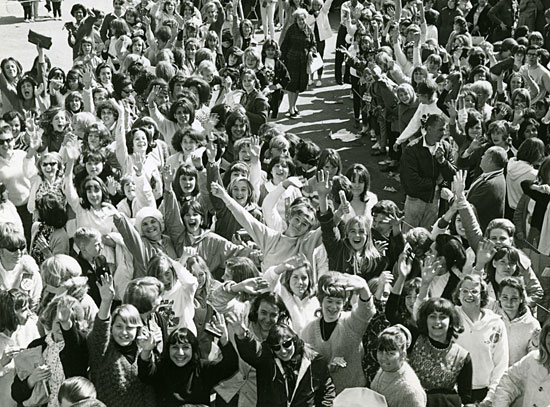





 Check for the latest closure information
Check for the latest closure information








